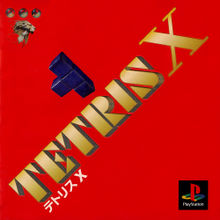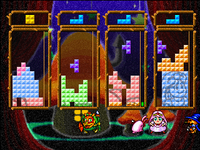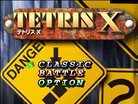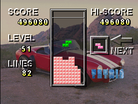Tetris X: Difference between revisions
Add link to tcrf |
m Remove unclear/untrue statement about non-Nintendo console releases. |
||
| (5 intermediate revisions by one other user not shown) | |||
| Line 2: | Line 2: | ||
|developer = [[Bullet Proof Software]] | |developer = [[Bullet Proof Software]] | ||
|publisher = [[Bullet Proof Software]] | |publisher = [[Bullet Proof Software]] | ||
|released = March 29, 1996 | |released = '''Tetris X'''<br>March 29, 1996<br>'''Tetris X The Best'''<br>June 27, 1997 | ||
|platform = PlayStation | |platform = PlayStation | ||
|boxart = | |boxart = Tetris_X_Cover.jpg | ||
|title-scrn = TetrisX title.png | |title-scrn = TetrisX title.png | ||
|ingame-scrn = TetrisX ingame1.png | |ingame-scrn = TetrisX ingame1.png | ||
| Line 14: | Line 14: | ||
}} | }} | ||
'''Tetris X''', released for PlayStation in Japan, is notable for being the first game | '''''Tetris X''''', released for PlayStation in Japan, is notable for being the first game released after the Tetris rights reverted to [[Alexey Pajitnov]] in 1996. [[The Tetris Company]] had been set up and had signed an agreement with Sony, giving a three year licensing right for the release of Tetris on the PlayStation in both Japan and the US. The game features a "Classic" single player mode, and a competitive "Battle" mode that allows up to 4 players to compete against each other. | ||
==Rotation System== | ==Rotation System== | ||
| Line 38: | Line 38: | ||
== External links == | == External links == | ||
*[http://www.din.or.jp/~koryan/tetris/d-psx.htm Koryan's page on Tetris X] | *[http://www.din.or.jp/~koryan/tetris/d-psx.htm Koryan's page on Tetris X] | ||
*[https://tcrf.net/Tetris_X The Cutting Room Floor on Tetris X] | *[https://tcrf.net/Tetris_X The Cutting Room Floor on Tetris X] | ||
[[Category: | {{Bullet-Proof Software games}} | ||
[[Category:Official Tetris games]] | |||
[[Category:PlayStation games]] | |||
Latest revision as of 12:48, 12 June 2023
| Tetris X | |
|---|---|
 | |
| Developer(s) | Bullet Proof Software |
| Publisher(s) | Bullet Proof Software |
| Platform(s) | PlayStation |
| Release | Tetris X March 29, 1996 Tetris X The Best June 27, 1997 |
| Gameplay info | |
| Next pieces | 1 |
| Playfield size | 10x22 Classic mode, 7x17 Battle mode |
| Hold piece | No |
| Hard drop | No |
| Rotation system | SRS predecessor. Wallkicks 1 cell left or right. |
Tetris X, released for PlayStation in Japan, is notable for being the first game released after the Tetris rights reverted to Alexey Pajitnov in 1996. The Tetris Company had been set up and had signed an agreement with Sony, giving a three year licensing right for the release of Tetris on the PlayStation in both Japan and the US. The game features a "Classic" single player mode, and a competitive "Battle" mode that allows up to 4 players to compete against each other.
Rotation System
The basic rotation is almost identical to that used in SRS, the one exception being the I tetromino: the spawn state, and the state achieved after 2 rotations in the same sense (a net 180° rotation) are swapped. Therefore, the I tetromino does not have a single rotation centre.
The wallkick behavior, however, is more akin to ARS, in that kicks are possible one cell left and right. Innovatively, there is no asymmetry (see Mihara's Conspiracy); the player is able to choose whether the tetromino will kick left or right by holding the appropriate direction on the d-pad. If no direction is held while the tetromino is rotated, no wallkick is tested.
Classic mode
A standard endless game of Tetris. The player's starting level is determined by the selected difficulty: "Easy", "Normal", "Hard" and "Expert" begin at levels 0, 11, 51 and 120 respectively. The player scores points and advances levels by clearing lines. No drop-scoring is awarded. For a given level, n, the player must clear a cumulative total of 10(n+1) lines to advance to the next level, and the scoring is as follows:
- single: 40(n+1) points
- double: 100(n+1) points
- triple: 300(n+1) points
- tetris: 1200(n+1) points
The level counter stops increasing at level 200 (so the maximum possible amount of points from a tetris clear is 241200). The lines counter stops increasing at 9999 lines. The score counter supports only 8 digits, and upon exceeding 99999990, the score is entirely replaced by the Japanese characters "いちおくてん" ("one hundred million points"), and stops increasing. However, after topping-out, the score is displayed as 100000000 in digits on the high score table.
Battle mode

Up to 4 human (or CPU) players can compete against each other with the aid of a multitap. Graphically, this mode is in stark contrast with the rest of the game, and in fact uses the cartoon-style characters from Tetris Battle Gaiden. Unusual features in this mode include the playfield size of 7x17, the facility to stockpile garbage lines before sending them to opponents, and the ability to choose which opponent to target when sending garbage lines.
External links
| ||||||||

